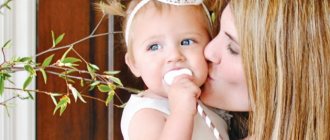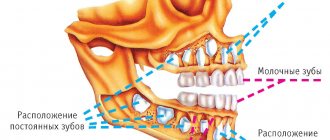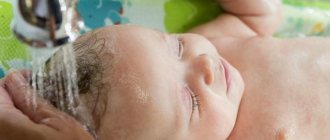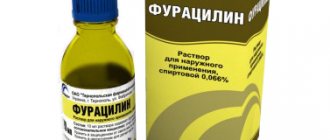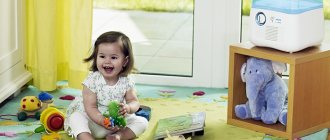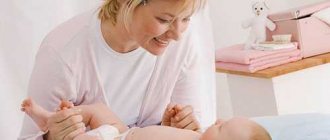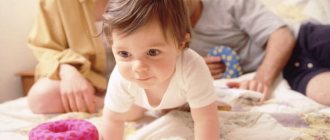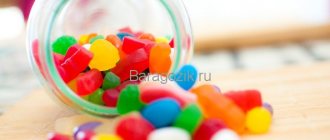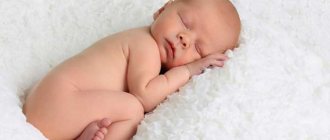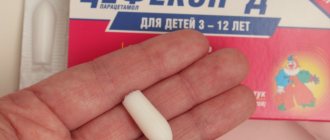How should you really clean your toddler's ears?
Why clean your toddler’s ears, and is it even necessary?
Of course it is necessary. But - not too often, and without much zeal.
As for earwax, which so irritates mom and dad, it’s forbidden to clean it out at all.
Despite its unattractive appearance, there are several functions that it performs in the body:
- “Lubricates” the eardrum, preventing it from drying out - helps moisturize the ear canal.
- Provides the function of protecting the ear canal from the entry of germs, dust, etc.
In addition, it is worth noting that after deep cleaning of the ears, this substance will be released many times faster, so mother’s diligence is of no use here.
Also, deep cleaning can lead to...
- Penetration of infection.
- Injury.
- Otitis (note: ear cleaning is the most common cause of otitis in babies under one year old).
- Violation of the integrity of the eardrum.
- The formation of an even denser sulfur plug.
- Hearing impairment.
If you suspect that there is a wax plug and requires immediate removal, immediately go to an ENT specialist!
It is forbidden to perform such manipulations yourself!
Caring for baby's ears: where do we clean and where not?
How to clean the delicate ears of an infant and, in general, does it make sense? This routine hygienic procedure requires certain skills and knowledge. It is imperative to clean your child’s ears, and this should be done not only from the inside, but also outside. If the area behind the ears is ignored during care, the child may develop discomfort, crusts, diaper rash, and even serious illnesses.
Crusts are formed due to gross non-compliance with hygiene rules. During the feeding process, breast milk drains and enters the folds behind the baby's ear, where it dries, subsequently forming crusts. They should never be removed dry, as this will cause severe pain to the baby. You can minimize the pain when removing crusts using a cotton pad slightly moistened with warm water.
In addition, crusts may indicate a childhood allergy. For example, their cause may be the use of low-quality shampoos for children or errors in the mother’s diet if the child is breastfed. Diaper rash occurs when a child's ears are not sufficiently dried after taking water treatments. The first thing you should do is not put on a cap after a bath, because the baby’s skin should breathe freely at least a little.
Young parents ask many questions about the health and hygiene of their newborn. Among other things, they are interested in whether the baby’s ears need to be cleaned, and if so, how. Let's talk about this in more detail.
Why is sulfur needed?
Earwax is present in the depths of the ear for a reason. It performs the important functions of cleansing and protecting the ear canals from pathogenic bacteria and fungal infections.
Earwax also provides lubrication and moisturization to the skin of the external auditory canal. Natural secretions help get rid of dead cells, dust and other impurities that settle in the ear canal.
Earwax is released by human actions such as yawning and chewing movements.
As a result, hypersecretion develops, and there is more wax in the ears than before. In addition, it ceases to fully perform its functions: the ear canal is deprived of proper protection and is not sufficiently moistened. Often the inner ear is injured by a cotton swab. Therefore, you need to clean your ears, but not too often, using other devices rather than cotton swabs.
This is especially true for infants.
The formation of the auricle of a newborn baby continues after birth. This means that the eardrum is too close to the entrance, and the cartilage does not close it, as it does in adults. The auditory canal of a small child is short and wide, without bends.
There is no bone section. All these features make the baby's ear very vulnerable. Therefore, any penetration into the ear canal can be fraught not only with unpleasant sensations for your child, but also with serious damage.
Therefore, the use of cotton swabs to clean children's ears is prohibited.
Before performing hygiene procedures, it is better to consult a doctor. It makes sense to clean your newborn's ears when you see excess wax on the surface of the ear. On average, ears can be cleaned once every 10 days. Most often, pediatric otolaryngologists recommend using cotton wool for these purposes.
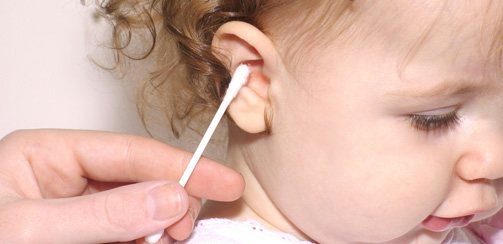
So, how to clean your child’s ears:
- choose the evening, preferably after swimming. Usually, after water procedures, babies are calmer and more relaxed. The ears will be slightly moistened, the wax will soften, which will only contribute to effective cleansing;
- Even before bathing, roll the cotton wool into flagella;
- Place the baby on a changing table or on a bed or sofa. Turn the head to the side so that you can clearly see the baby’s ear (it is advisable to carry out the procedure in a well-lit room);
- Take a cotton swab and gently wipe the outer (visible) part of your ear. There is no need to go deep into the ear canal so as not to harm the child. Even if there is sulfur there, it does not need to be removed. We have already talked about the beneficial properties of this substance;
- Clean the second ear using the same procedure.
Don't forget about hygiene behind your ears. After each bath, this area must be wiped dry with gentle movements, like any other folds on the baby's body. To cleanse the skin behind the ears, use cotton pads folded in half. Gently blot the area behind the ears without applying too much pressure to your baby's skin.
If you choose a time for hygiene other than after bathing, you can use two types of cotton swabs and pads - dry and wet.
After this, blot the baby's ears with a dry flagellum and disk. This way the cleansing will be maximum.
Please note that if the baby resists, is capricious, or simply not in the mood, then it is better to perform the procedure another time. Otherwise, you may cause harm with your actions, and the cleansing will not be complete. In addition, if you forcefully clean your ears, over time you will develop a dislike for this procedure.
If the area behind the ears is cleaned incorrectly and untimely, crusts and diaper rash may form there. Some parents are not very attentive to the child during feeding. But milk often flows down the baby’s cheeks, heading straight into the fold behind the ear. There it dries and turns into a crust.
We invite you to read: Proginova when planning pregnancy: how to take it, how to combine it with duphaston, utrozhestan and clostilbegit, why it is prescribed for IVF
This brings a lot of unpleasant sensations to the child - he may be capricious, cry, worry. Therefore, regularly check how clean your child’s ears are. If you notice such a crust, then under no circumstances remove it dry. First, moisten it with warm boiled water and let it soak.
Then carefully remove using a cotton pad or ball.
As for diaper rash, this problem occurs when the skin is not completely dry. Perhaps the parents, without allowing the hair to dry completely, put a cap or cap on the baby. As a result, a wet hat will cause diaper rash in the baby.
Do not impose your own ideas on the little person about what is good for him and what is bad. The baby's body is no more stupid than its parents.
In order not to harm your own child, remember a few taboos when cleaning a baby’s ears:
- use cotton swabs or toothpicks/matches with cotton wool wrapped around them;
- use different oils when cleaning your ears;
- start cleaning your baby’s ears if you have long nails;
- try to independently remove wax plug or any foreign object. In this case, you should immediately visit an otolaryngologist.
All children in the first year of life should be examined by an ENT specialist, as well as other specialists. However, there are cases when you should make an urgent visit to a specialist:
- there is discharge from one or both ears;
- there is an unpleasant odor coming from the child’s ears;
- the color and consistency of sulfur suddenly changed;
- the ear is red and inflamed;
- a foreign object has entered the ear canal;
- presence of sulfur plug.
In all of the above cases, do not delay - visit the ENT specialist. We are talking about your child's health.
So, you can and should clean your baby’s ears. The main thing is to adhere to simple rules and carry out the procedure in accordance with the recommendations of specialists.
Health to you and your children!
What else do you need to remember?
- How to clean your ears? The most popular options are a flagellum made from a cotton pad or an ordinary CHILDREN'S cotton swab with a limiter. This restriction prevents the stick from penetrating too deeply into the ear and protects it from injury. Important: a cotton bud can leave lint in the baby’s ear, which can not only cause discomfort, but also inflammation.
- At what age should I start? Cleaning the ears is a delicate process, and in the first weeks of a baby’s life such a procedure is unnecessary. You can start cleaning after 2 weeks, when the baby adapts to the outside world.
- What can't you clean? Any devices that are not intended for these purposes - from matches and toothpicks to ordinary cotton swabs. Also, you should not use oils, milk and other “improvised” means to lubricate the flagellum or stick.
- Permitted means. The list consists of only 1 item: hydrogen peroxide – exclusively fresh and not higher than 3%. True, babies don’t need it for regular ear cleaning either, and besides, it’s permissible to use the product no more than once a week.
- How often to clean? Starting from 2 weeks, your baby's ears can be cleaned once a week or a week and a half. The procedure includes cleansing the auricle and the area around the outside of the ear.
- When to clean? The ideal option is to bathe the baby, feed it and immediately start cleaning the ears. After bathing, the wax in the ears will soften, and as a result of sucking movements it will come out from the depths of the ear canal.
How to properly apply a compress to a child’s ear - instructions
How to clean children's ears - instructions for parents
- After bathing, soak cotton swabs (with a limiter!) or cotton pads in boiled warm water or a weak peroxide solution. Wet it lightly so that it doesn’t drip from the “tool”!
- Place the baby on her side on the changing table.
- Carefully clean the area around the ear canal (not inside it!) and the auricle itself.
- Next, moisten a cotton pad with boiled water and carefully clean the areas of the ear folds (behind the ears). Next, blot these areas dry so that no moisture remains.
- It is recommended to wipe the ears and areas behind the ears every day, and near the ear canal - once every 7-10 days.
- It is unacceptable to use one stick (flagellum) for both ears.
How to give an enema to a newborn baby - instructions
How to properly clean a child’s ears at home - everything about cleaning children’s ears
Human ears have a complex internal structure that allows us to hear. To protect its three sections from external factors, wise nature provided the presence of a natural antiseptic - earwax.
It is produced in small quantities daily and coats the outer part of the ear canals. When there is a lot of sulfur, it appears in the ear. And it is these excesses that need to be removed.
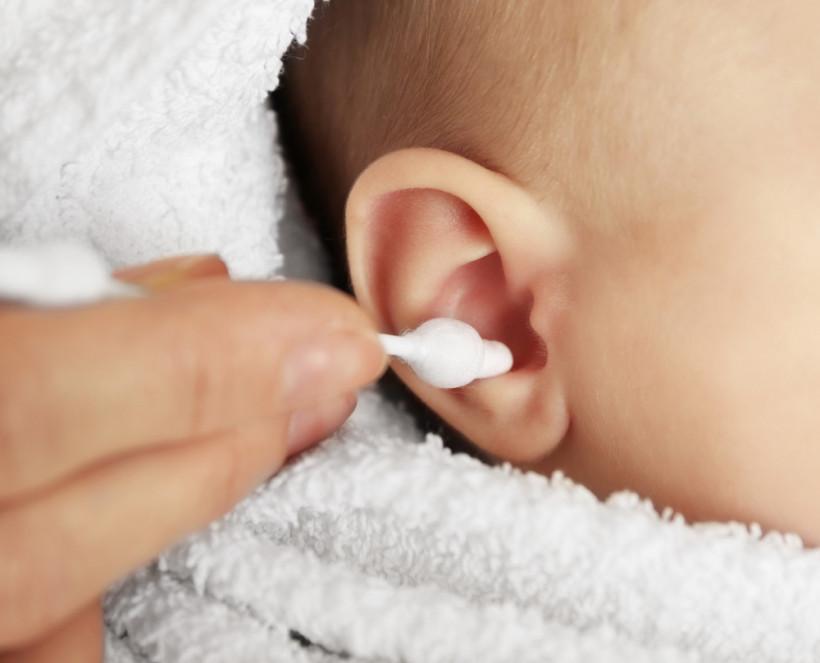
If you actively extract the natural secretion from the “depths” of the ear, its quantity will actively increase and bring even more pollution.
Caring for your newborn's ears should become part of your daily routine. You don’t doubt that you need to wash your eyes or brush your teeth every day, do you? And you probably won’t calmly watch how a newborn’s navel bleeds? But in this delicate matter you need to know when to stop. Here are a few rules on how to clean a baby's ears that must be followed.
- Care for the area behind your ears every day. Make sure that there are no traces of breast milk or formula left there, as they can cause diaper rash and inflammation.
- Clean the inside of your ears once a week. Eliminating excess wax is necessary to maintain ear hygiene and reduce the risk of developing inflammatory processes.
- Use special children's cleaning accessories. Cotton swabs for children are suitable for you. The shape of their heads is not as elongated as for conventional sticks, and has restrictions that prevent the object from passing deep into the ear.
- Remove water from ears after bathing. Every mother worries: is it possible to wet the ears of a newborn? We will answer this way: it is possible, but without fanaticism. If water accidentally gets into your baby’s ears, after the bath procedures you need to roll up two cotton pads and place them shallowly in the ear canals for a couple of minutes. The cotton wool will quickly absorb moisture, and there will be no reason to worry.
- Never try to clean the ear deeper, do not put cotton wool inside. And if you do push something in there, don’t try to get it out yourself. Urgently contact an otolaryngologist who will reap the benefits of your efforts as safely as possible.
It is advisable to clean a newborn’s ears after bathing: dirt will be removed better, and soaked wax can be easily removed with a cotton swab. You can also clean your ears after feeding. The sucking movements of the baby's mouth push the wax to the exit.
- Prepare special children's cotton swabs with limiters or make a gauze swab.
- Turn the baby's head on its side and begin to lightly wipe the ear with a stick or swab dipped in water. Pay attention to each fold of the ear and wipe the visible part of the ear canal.
- Change the stick or swab and wipe the second ear. If there is a lot of sulfur, do it as it gets dirty.
Do not exert any physical force or forcefully pull on your ears. If the baby finds this procedure unpleasant, maintaining hygiene will become more difficult in the future. And if the baby is spinning or protesting, leave the cleaning until you are in a more favorable mood. It’s better to let your ear remain “dirty” for a couple of days than to accidentally poke it into the depths of the ear canal with a stick.
A pediatrician tells how to treat a baby's nose, ears and eyes.
It is important to maintain cleanliness not only in the ears themselves, but also behind them. Often, inattention to this area results in discomfort for the baby. When a newborn’s ears get wet, the integrity of the skin is compromised, which is unpleasant and dangerous, as it can lead to the development of a bacterial infection. Let's look at possible problems.
- Scabs behind the ears of a baby. They arise due to a lack of basic hygiene, when breast milk or formula flows down the baby’s cheeks during feeding and partially remains in the ear folds. If this area is not washed and dried daily, the mixture may dry out and form crusts. They provoke itching and anxiety in the baby, and removing them dry is painful. However, they quickly soak in water and are simply removed with a cotton swab. In other cases, crusts occur as a manifestation of an allergic reaction. Remember what products you consumed the day before (if the baby is breastfed), and whether you used a new baby cream or oil. Eliminate anything suspicious mercilessly, as allergic peeling of the skin will only increase.
- Diaper rash behind the ears in newborns. They occur due to insufficient drying of the parotid area after bathing. Perhaps the moisture remains on the hairs, and after the “bath” you put a cap on the baby and prevent the skin from drying. At the initial stage, free access of air and thorough blotting after bathing will help get rid of diaper rash. If the skin becomes painful, turns red and causes discomfort to your baby, be sure to consult a doctor. He will prescribe you an antiseptic ointment that will quickly relieve inflammation.
Now you know how to clean your newborn's ears and why it's important to do it regularly. Spend just a couple of minutes a day on this activity, and ear problems will not affect you!
lesson “5 tips for caring for a baby.”
Support the project - share the link, thank you!
With the birth of a baby, mothers have certain responsibilities. And we are not talking about regular diaper changes and hourly meals. Regular bathing and changing clothes, treating the umbilical wound and, of course, cleaning small ears - any hygiene procedure makes new parents tremble at the knees. Today we’ll talk about how to clean newborns’ ears.
Is this hygiene procedure necessary at all? Of course, yes - this part of the body needs regular care and attention. To properly perform the hygiene procedure, you need to become familiar with the structural features and the most important properties of the ears.
The ears of a newborn baby differ in structure from the auricle of an adult. That is, if you really want to pick your ears with a cotton swab, then do so, but under no circumstances clean your child’s small ear with it.
We suggest you read: Night cough in a child, possible diseases and how to relieve attacks
The thing is that in the first days of life, the baby’s shell is not fully formed - the eardrum is very close to the entrance and is not protected by natural cartilage. This means that one wrong move can lead to unpleasant sensations, for which, if the baby is older, you can get hit in your own ear.
A newborn's ears are a delicate part of the body that needs to be treated with special attention and cleaned carefully.
The auricle produces a natural antiseptic - earwax. It accumulates in the inner ear and only appears outward when there is a large amount. It is these excesses that need to be removed from the outer ear of the newborn.
In simple terms, sulfur is not dirt and is not a sign of an unkempt baby. Therefore, dear mothers, take care of your baby’s ears, do not overdo it with your efforts - leave a little wax in the canal. For what? - you ask. It turns out that its absence is not good for the ears.
Sulfur is needed in order to:
- Moisturize the ear canal and prevent the eardrum from drying out;
- Protect the inner ear from the penetration of pathogenic microbes and other evil spirits.
Sulfur cannot be removed completely, since its complete absence will provoke even greater production. Strong intensity of cleansing (mechanical movements with everyone's favorite cotton swabs) can cause a number of other complications that will bother the ears of a newborn baby.
After reading all this, you will probably think about whether and how to clean the ears of a newborn baby. Of course, it is possible and even necessary. You just need to follow certain recommendations so as not to harm your child.
Ears, like any other part of the body, need proper attention and care. You don’t doubt that you need to brush your teeth every day and wash your face in the morning? And you won’t calmly watch how the umbilical wound is bleeding, right? Likewise, a newborn’s ears need to be given attention every day, every fold of the ear needs to be cleaned.
Do you still clean your ears with cotton swabs? Then we are coming to you with useful news:
- For a long time, special devices with a limiter have been invented for infants, which allow you to effectively clean the ears of a newborn.
- For hygienic procedures, you should never use common cotton swabs. Buy only special ones for children, with a limiter that will not allow you to reach the eardrum.
- After bathing, be sure to remove water from the ear. You might be thinking about whether it’s okay to wet a newborn’s ears? Of course you can, but very carefully. If liquid gets in, roll up two halves of a cotton pad and carefully place them in the ear for a while, and then clean with gentle movements.
Attention! Under no circumstances try to get the sulfur from the inside and push it through with cotton wool. But if you still happen to get into trouble, do not try to remove the foreign object yourself - take your newborn baby to an otolaryngologist who can remove the fruits of your efforts.
How to clean?
It is advisable to clean the ears of a newborn baby after an evening bath: the child will be calm and relaxed, the skin in the auricle and excess wax will be slightly soaked, which promotes quick cleansing. Useful article about what water to bathe a newborn baby in {amp}gt;{amp}gt;{amp}gt;
- Prepare all the necessary tools in advance: special cotton swabs and a swab;
- Turning the newborn baby's head on its side, gently wipe the ear with a cotton pad or swab dipped in a small amount of boiled water. Pay attention to every fold and visible part of the ear canal;
- Do the same with the second ear.
Your baby may kick and be fussy. After all, he shouldn’t be purring with pleasure like a kitten. If there is an obvious protest, it is better to postpone the procedure until safer times. It’s better to leave your ears dirty than to accidentally poke a newborn baby’s eardrum with a stick.
How to use hydrogen peroxide to remove a plug for a large child?
- We buy 3% peroxide at the pharmacy (ideally 1%).
- We use only warm solution!
- Dilute peroxide 1 to 10 with boiled (distilled) water.
- We place the baby on his side and instill 3-4 drops of the product into the ear using a regular syringe (without a needle, of course).
- We wait 5-10 minutes and carefully treat the area around the ear canal, removing wax. It is forbidden to go inside the ear!
Remember that a 6% peroxide solution can cause a chemical burn!
In case of serious traffic jams, a visit to an ENT specialist - the baby will be relieved of the traffic jams, and the mother will learn how to clean the ears correctly.

The most popular of them with answers from pediatricians - for your attention!
- During cleaning, the child started bleeding from the ear - why, and what to do? The most common cause is trauma to the ear canal. True, damage to the eardrum cannot be ruled out. In this case, it is recommended not to delay and immediately contact an ENT specialist.
- A child coughs or sneezes while cleaning his ears - is it harmful to continue cleaning his ears in this case? Of course, you should not continue - there is a risk of damage to the eardrum and serious injury to the ear.
- There is a suspicion that the child has wax in the ear. Is it possible to clean your ears at home? It is not recommended to remove wax plugs at home yourself! A specialist removes plugs quickly, using special tools and rinsing.
- After cleaning the ears, the child constantly cries, the ear hurts - what to do? The main cause of pain after ear cleaning is too aggressive and deep cleaning. It is unacceptable to climb inside the ear canal! If the baby cries constantly, even when the ears are cleaned externally, it is strongly recommended to consult a doctor - otitis media may develop or there may be an injury.
- Is it harmful to put hydrogen peroxide in a child’s ears to remove wax? This product is not recommended for cleaning the ears of babies under 6 months. Also, peroxide should not be used for otitis media and hypersensitivity. The decision to use peroxide is made by the ENT specialist, depending on the disease.
- How to dry your child's ears after bathing? It is unacceptable to dry your ears with a hairdryer (this also happens), warm them up with a heating pad, use a syringe, shake your baby, or shove sticks into your ears to absorb water! Moisture is removed by blotting with a cotton pad or inserting cotton wool to a depth of no more than 0.5 cm. After bathing, the baby is placed on one side so that all the water drains out, and then onto the other side.
The site Colady.ru thanks you for your attention to the article! We will be very pleased if you share your feedback and tips in the comments below.
How to properly clean an infant's ears, and is it necessary to do so?
Earwax accumulates in a child's ears, just like in any adult. It is often said that the deeper we clean our ears, the better. But this is far from true.
It is necessary to care for a newborn's ears very carefully and strictly according to the rules, as they are easily damaged. It must be remembered that the eardrum at this age is not yet protected, and the length of the ear canal is very short.
An infant's ears should be cleaned at least once every 10 days.
Of course, your baby’s ears need to be cleaned, but you still shouldn’t be too zealous. Such procedures must be completed in a timely manner. Cleaning out sulfur very often is not only not recommended, but also prohibited.
Of course, it looks terrible, but it performs useful functions:
- Sulfur helps keep the eardrum from drying out and moisturizes the ear canal.
- Protects the ear canal from various microbes.
That is why, if you are trying to completely clean out all the wax several times a day, you should know that a lack of earwax can lead to various infections. The second disadvantage of frequent ear cleaning is that wax begins to be released twice as fast.
You can clean your newborn's ears with a cotton swab or a cotton pad rolled into a flagellum. Sticks for adults are not suitable for these purposes; you need to buy special ones for baby ears. These sticks are distinguished by the presence of a special limiter that prevents penetration deep.
Cotton swabs should be moistened in a weak solution of hydrogen peroxide or simply in warm boiled water.
- A child's ears are so delicate that they can easily be damaged, which is why this procedure should be performed by a person whose nails are cut short.
- You cannot clean your baby's ears with a toothpick with cotton wool wrapped around it - you can damage the ear.
Pediatricians advise cleaning your baby's ears after an evening bath or morning feeding. Moms will ask: “Why is this so?” After morning feeding, the baby begins to push out sulfur, which is why it will be very easy to remove.
After an evening swim, droplets of water fall into the ears, the wax softens, and then it can be removed without damaging anything. You should also remember that children's ears do not like water inside, which is why it is necessary to remove it from the child's ears after each bath.
If you do not do this, inflammation or otitis may occur, and you will have to consult a doctor.
You should contact an otolaryngologist not only for routine checks, but also in the following cases:
- The sulfur does not come out of the ear canal. You should not remove it at home, as it can push even deeper, and it will be more difficult to get rid of it. The doctor will help remove wax quickly and painlessly.
- You should also contact a specialist if you notice an unpleasant odor coming from your baby’s ears.
- If there is discharge from your baby's ears, you should immediately consult a doctor.
- The sulfur has changed color and consistency. The shade of sulfur can range from yellow to dark brown. In the event that the color and consistency have changed dramatically, then it is necessary to urgently contact an otolaryngologist for help.
- Redness or inflammation of the ear.
- Foreign body in the ear canal.
It is necessary to clean a baby's ears, but this should be done very carefully, in a special way, not in the same way as adults. How to clean your ears correctly?
- You only need to clean the part of the ear that is clearly visible. That is, the auricle. Penetrating deep into the ear can harm the child.
- It is necessary to clean only with specially designed sticks or rolled cotton pads.
- To clean your child's ears, place him on a flat surface and turn his head to the side.
- If you find a sulfur plug, then you should not try to remove it yourself, you need to contact a specialist.
There are few recommendations for cleaning the ears of babies, but they should definitely be used. If you ignore the advice, you can harm your child.
- First, you need to place the baby on a flat surface and turn his head to the side.
- Then you should soak a cotton swab or swab in hydrogen peroxide or warm water. Under no circumstances should you wet the cotton wool too much.
- Next, you need to wipe the baby’s ear, without penetrating deeply.
- You should remember that if you notice accumulations in your baby’s ear canal, you should not clean it yourself; it is better to contact an otolaryngologist.
- Also, use a cotton pad slightly moistened in a weak solution of hydrogen peroxide to wipe behind the ear.
We invite you to read: Premature baby: care features
Children under one year old should clean their ears with caution.
In order for everything to go well, you must strictly adhere to the above recommendations and rules.
When you bathe your baby, you should be careful not to let water get into the ears. If, nevertheless, it penetrates there, you need to take a dry cotton swab and apply it to the external auditory canal - this will help dry it.
After feeding, you need to place the baby standing, because if this is not done, the baby will burp and the milk will fall into the Eustachian tube, which connects the ear to the nasopharynx.
In windy and cold weather, the baby should definitely wear a hat that covers the ears. The hat must be selected so that it is not too cold or too hot. The heat may cause prickly heat or diaper rash.
Newborn babies' ears are cleaned with folded gauze or a cotton swab with a stopper at the end. A rolled-up cotton pad will do. It is strictly forbidden for a one-year-old child to use chopsticks for adults. If you move them carelessly, you can damage your child's eardrum. For children over one year old, cotton swabs should also be used with extreme caution.
There are a few basic principles to keep in mind:
- Do not wet cotton swabs. As a last resort, you can dip it in warm boiled water.
- If there are formations on the auricle and behind it, do not try to get rid of them yourself, but consult an ENT specialist.
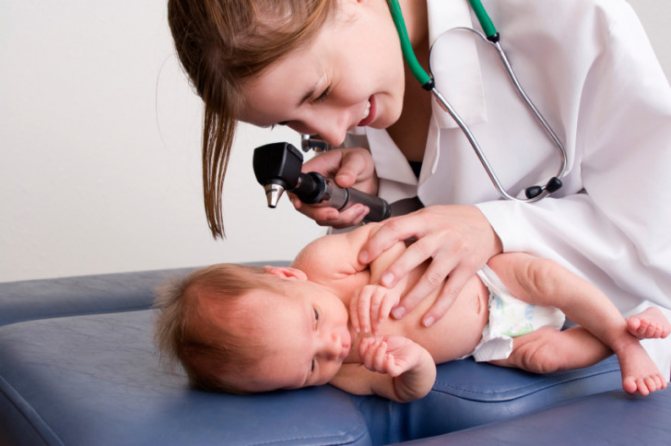
If a baby has formations in the ear, it is better to seek the help of a specialist
